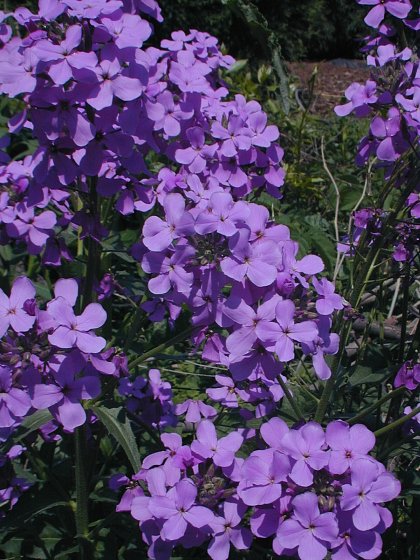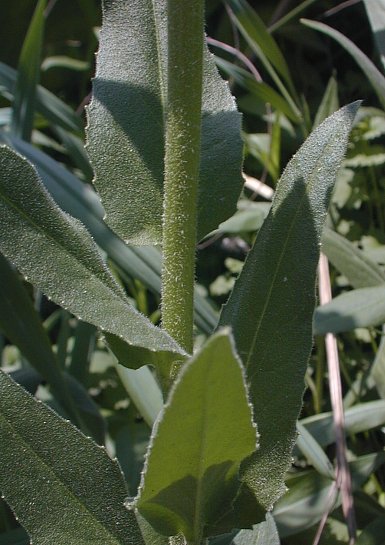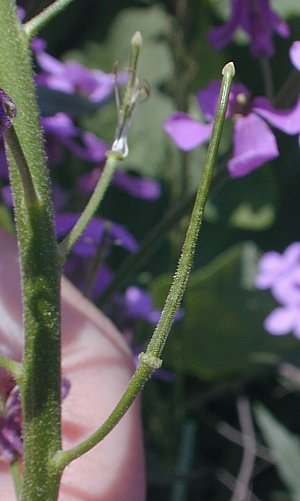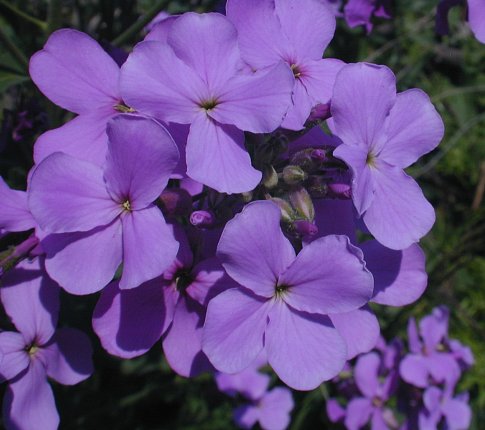Description: This plant is a biennial or short-lived perennial that is sparingly branched, except where the racemes of flowers occur. It is normally erect and about 2–3½' tall. The stems are round and pubescent. The alternate leaves are up to 6" long and 2" across. They are lanceolate, pubescent, and dentate with widely spaced teeth along the margins. The lower leaves usually have short petioles, while the upper leaves are sessile and slightly smaller in size. The base of each leaf is well-rounded or wedge-shaped, but never cordate.

The upper stems terminate in racemes of flowers about 6-18" long. Each flower is about ¾–1" across and long, consisting of 4 rounded petals, 4 linear-lanceolate sepals, several stamens, and a pistil. The petals are bright purplish pink fading to pink or nearly white. The sepals are pinkish green and pubescent. The calyx is cylindrical in shape and has only a narrow opening at the throat of the flower. The pedicels are pubescent and up to 1" long. The blooming period occurs from late spring to mid-summer and lasts about 1–1½ months. There is a pleasant floral scent that reportedly becomes stronger at night. The flowers are replaced by ascending siliques (narrowly cylindrical seedpods) that are about 1½-4" long at maturity. These siliques are slightly pubescent and several-seeded. The seeds are somewhat flattened and ellipsoid-oblongoid in shape. The root system consists of a taproot and coarse secondary roots.

Cultivation:
The
preference is partial sun, moist to mesic conditions, and fertile loamy
soil. Sometimes this plant grows in full sun when there is sufficient
moisture.
Range & Habitat:
The non-native Dame's Rocket is an occasional plant that occurs in NE
Illinois and
scattered counties elsewhere (see Distribution
Map). This species was introduced from Europe as an
ornamental plant
and it has been grown in gardens since the Roman Empire. Habitats
include
moist meadows, woodland edges and openings, thickets, semi-shaded fence
rows, banks of drainage ditches, vacant lots, edges of yards, and
flower gardens. Dame's Rocket is still cultivated as an ornamental
plant, even though it sometimes invades natural habitats, particularly
those that are partially
shaded.

Faunal
Associations:
The primary pollinators of the flowers are butterflies and moths, which
suck nectar. Other insect visitors, with one or two exceptions, are
less effective at pollination and are attracted by the pollen (their
mouthparts aren't long enough to reach the nectar). Müller of 19th
century Germany observed the following visitors: White butterflies,
Soldier flies, Syrphid flies, Halictid bees, Andrenid bees, and
honeybees. Among the Syrphid flies, a Rhingia sp.
was observed sucking nectar because of its exceptionally long
proboscis. Information about this plant's relationships to birds and
mammals is currently unavailable.
Photographic Location:
An old garden along a back alley in Urbana, Illinois.

Comments: It's easy to see why Dame's Rocket is grown in flower gardens. However, it is something of an escape artist that often naturalizes into adjacent areas. The only other plant in Illinois that resembles this species is Lunaria annua (Money Plant). This latter member of the Mustard family also has large purplish pink flowers and it has a similar height. The seedpods of the Money Plant, however, are quite different in appearance: they are shaped like large coins with a short stipe in front and a short beak in back. The seedpods of Dame's Rocket, on the other hand, are narrowly cylindrical. The foliage of these two species is also somewhat different: the lower leaves of Money Plant often have cordate bases (i.e., they're indented near the petiole), while the lower leaves of Dame's Rocket have bases that are well-rounded or wedge-shaped. Another group of plants with similar flowers are the Phlox spp. (Phloxes). However, Phloxes have flowers with 5 petals and their leaves are opposite along the stem and more narrow.